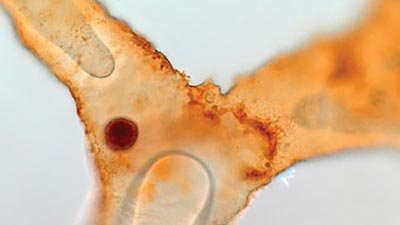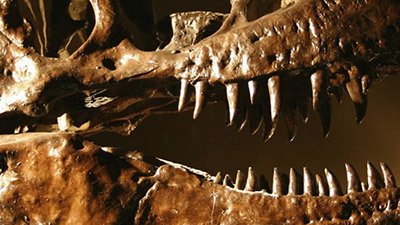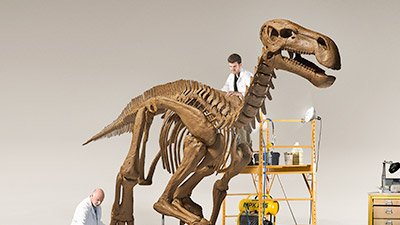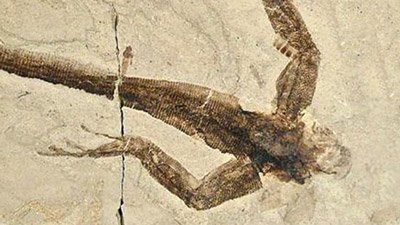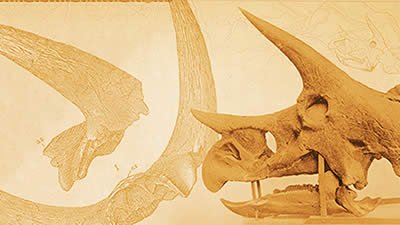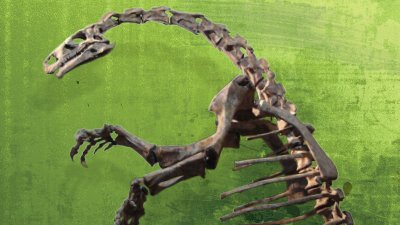Dinosaur Bones
Dinosaur Bones with DNA
The survival of DNA within dinosaur bones would be powerful evidence against a millions-of-years age for those fossils. The findings support the view that these dinosaurs lived only 4,300 years ago and were buried during the global Flood.
Collagen and Keratin in Fossil Bones
A team in England confirmed the existence of soft skin tissue, known as keratin, in fossilized lizard skin. A team in Sweden showed that collagen has survived in the fossilized bone of a mosasaur. Since the researchers believe these fossils are 50 to 70 million years old, they need to explain how fragile biological molecules can survive so long.
Dinosaur Bones Hard for Evolutionists to Explain
Textbooks often show fossils slowly forming over time as animals lay on the ocean floor. However, real-life fossilization shows signs that it happened quickly. Soft-bodied animals like squid and jellyfish have been fossilized, as well as animals in the process of eating one another or giving birth. The global flood would have created the perfect conditions for fast fossils.
News About Dinosaur Bones
-
May 30, 2025 from Ken Ham Blog
Alberta, Canada, is famous for dinosaur fossils, including a densely packed “mass grave” of pachyrhinosaurs.
-
Nov. 30, 2023 from Ken Ham Blog
Scientists working in Mongolia at the Barun Goyot Formation uncovered an unusual fossil—a nearly complete skeleton of a creature curled up like a bird.
-
May 25, 2023 from Ken Ham Blog
In 2004, a team led by Dr. Mary Schweitzer discovered soft tissue—red blood cells, blood vessels, and collagen—in the femur of a T. rex. How could soft tissue last that long?
Articles About Dinosaur Bones
-
April 1, 2024 from Answers Magazine
Soft tissue poses a problem for evolutionists—but it confirms the biblical timeline.
-
Dec. 15, 2017 from Answers in Depth
The presence of tissue, cells, and proteins remaining in dinosaur fossils poses a direct biochemical challenge to the standard geologic dating paradigm.
-
March 31, 2017 from Answers in Depth
Observable science confirms preserved collagen fragments in dinosaur bone are authentic, but does not show protein can be preserved for millions of years.
-
Oct. 20, 2016 from Answers in Depth
Despite a large body of evidence for the authenticity of the dinosaur tissue, there remains a pattern of denial within the evolutionist community.
-
Feb. 7, 2016 from Answers Magazine
The Bible reveals when dinosaurs first walked the earth and when most were destroyed. But do we know what they really looked like and how they lived?
-
In-Depth ArticleDo Proteins in Dinosaur Blood Vessels Map Evolutionary History?Jan. 9, 2016 from Answers in Depth
Scientists believe protein sequences from dinosaur blood vessel walls may help them map evolutionary relationships.
-
Nov. 15, 2015 from Answers Magazine
For decades, dinosaurs have troubled Christians who didn’t know how to explain them from the Bible.
-
Magazine Department ArticleCowboys and DinosaursOct. 1, 2015 from Answers Magazine
How does cowboy life intersect with creation? Dinosaurs.
-
Oct. 12, 2014 from Answers Magazine
Soft skin tissue, known as keratin, has been found in fossilized lizard skin from the USA’s Green River Formation.
-
July 17, 2014 from Answers in Depth
Triceratops skulls entombed in Montana’s Upper Cretaceous Hell Creek Formation tell a story, but not the tale of being trapped by the sands of time!
-
Semi-Technical In-Depth ArticleIron Key to Preserving Dinosaur Soft TissueDec. 4, 2013 from Answers in Depth
Iron may be the key to the surprising preservation of dinosaur soft tissue.
-
Triceratops Tally up to Four in New Wyoming Dinosaur GraveyardSept. 2, 2013 from News to Know
Ongoing excavation uncovers a fourth Triceratops in Cretaceous dig.
-
Magazine Department ArticleOne Step Closer to Jurassic ParkApril 1, 2013 from Answers Magazine
What researchers are seeing clearly does not support their beliefs about earth history over millions of years.
-
-
Preservation of Cellular Proteins in Dinosaur FossilsOct. 27, 2012 from News to Know
Evidence demonstrates preservation of cellular proteins in dinosaur fossils.
-
Choice of Timeline Determines StoryMay 5, 2012 from News to Know
The Jurassic jawbone of a long extinct creature has resurfaced in China to add a new chapter to the saga of its mysterious identity.
-
Group of Infant Dinosaurs Found In Fossilized NestNov. 26, 2011 from News to Know
Dinosaur babies frozen in time
-
Origins of the GiantsNov. 19, 2011 from News to Know
South American sauropodomorph fills in the gap.
-
Dinosaur Teeth Hold Clues to Whether Species Was Warm or Cold-BloodedJuly 2, 2011
Warm-blooded, cold-blooded, or none-of-the-above?
-
-
Four Dinosaur Skulls Reveal Sauropod DinosaurFeb. 27, 2010 from News to Know
Four dinosaur skulls recovered from Utah’s Dinosaur National Monument reveal Abydosaurus mcintoshi, a huge sauropod dinosaur thought to have swallowed its meals whole.
-
Magazine ArticleTwo: Those Not-So-Dry BonesJan. 1, 2010 from Answers Magazine
If dinosaurs died millions of years ago, how can their fossils still contain soft tissue?
-
What Was Missing on 60 Minutes Sunday Evening?Nov. 16, 2009
Discerning viewers of Sunday evening’s 60 Minutes program about a remarkably preserved dinosaur bone should have noticed something missing.
-
Preserved T-rex Ancestor FossilNov. 7, 2009 from News to Know
What’s the cause for our sixth mention of T. rex in seven weeks? A new study of the famed dinosaur’s “most ancient fossil relative” that is “exquisitely” preserved.
-
Ailing T-rexOct. 3, 2009 from News to Know
For all its size and strength, one mighty T. rex may have ultimately succumbed to a minuscule parasite.
-
Dinosaur MummyJuly 4, 2009 from News to Know
A “mummified” dinosaur with soft tissues fossilized—evidence of watery disaster?
-
Antique ProteinMay 9, 2009 from News to Know
An incredible discovery that shocked the “millions of years” camp is back—with further verification.
-
Magazine Department ArticleTissue IssueJan. 1, 2009 from Answers Magazine
If dinosaurs were millions of years old, the soft tissue of the T. rex would have surely disappeared long ago.
-
Soft Tissue found In Dinosaur Sparks New DebateAug. 2, 2008
The much-publicized soft tissue found inside a T. rex thigh bone (supposedly millions of years old) may not be dinosaur protein after all.
-
Dec. 13, 2007 from Answers Magazine
The largest dinosaur grave in Europe has been unearthed.
-
Ireland's Sea DragonOct. 13, 2007
Found in Colin Glen, an area described by park ranger Paul Bennett as “rich in fossils and [...] of great geological interest,” the 2 3/4-inch (7 cm) section of backbone is from a plesiosaur said to have lived more than 144 million years ago and possibly as long as 190 million years ago.
-
Tyrannosaurus rex: a Big Chicken?April 14, 2007
Perhaps one of the most exciting recent discoveries for creationists has been the report of soft tissue found in a dinosaur fossil.
-
Marrow from a RexApril 14, 2007
Researchers have extracted and analyzed bone marror from a Tyrannosaurus Rex.
-
T. rex DrumstickApril 13, 2007
Finding T. rex soft tissue is compelling evidence that it was not 65 million years ago that dinosaurs died out, as given on the evolutionary timeline.
-
The Scrambling ContinuesMarch 6, 2006
Evolutionists continue to attempt to explain the presence of soft tissue in a T. rex bone a year ago.
-
“Ostrich-Osaurus” Discovery?March 28, 2005
Scientists have recently made the startling discovery of a dinosaur skeleton that still retains well preserved soft tissue.
-
Magazine ArticleA Living Dinosaur?Dec. 1, 2000, pp. 56–57
According to a report in Papua New Guinea's The Independent newspaper, a 'dinosaur-like reptile' was seen on two occasions in the Lake Murray area, in Western Province.
-
Magazine ArticleFresh Dinosaur Bones FoundJune 1, 1992, pp. 16–17
Fresh (not permineralized, meaning unfossilized) dinosaur bones had been found in Alaska. Such bones could never have lasted 70 million years.
Recommended Resources

Answers in Genesis is an apologetics ministry, dedicated to helping Christians defend their faith and proclaim the good news of Jesus Christ.
- Customer Service 800.778.3390
- Available Monday–Friday | 9 AM–5 PM ET
- © 2026 Answers in Genesis




